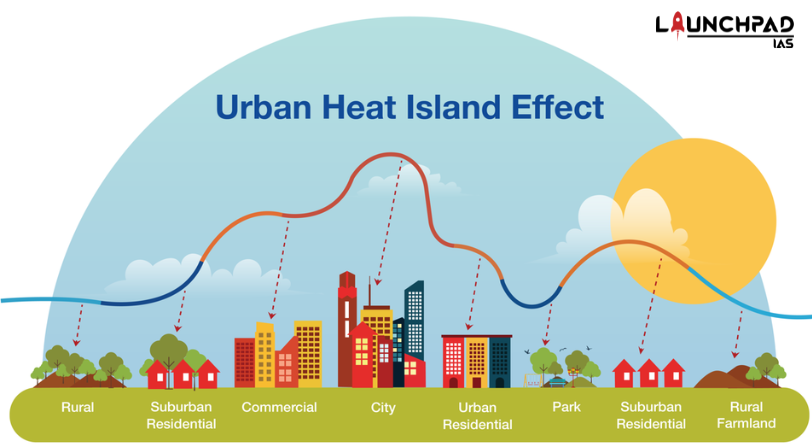About
- Urban Heat Island may be defined as the local and temporary phenomenon in which certain pockets within a city are experiencing a higher heat load than its surrounding area.
- This heat rise happens due to buildings and houses in cities made up of concrete where the heat is trapped and not able to dissipate easily.
- Urban heat island is induced due to trapped heat between establishments made up of concrete.
- The temperature variation can range between 3 to 5 degrees Celsius.
Why are Cities Hotter than Rural Areas?
- It has been observed that greener localities experienced lower temperatures than non-green localities.
- Green vegetation like plants, trees, and forests are prominent factors in regulating the incidences of the urban heat islands.
- Rural areas are blessed with more green cover in the form of plantations, farmlands, forests, and trees than urban areas.
- Transpiration is the phenomenon that plants carry to regulate the temperature.
- In urban areas is the basic cause of Urban Heat Islands in urban areas.
- Frequent construction of high-rise structures, roads, parking spaces, pavements, and public transportation transit lines has accelerated the incidences of urban heat islands.
- It occurs with black or any dark-colored material.
- Buildings in cities are often made of glass, bricks, cement, and concrete. All of them are dark-colored materials, which attract and absorb more heat
Causes of Urban Heat Island
- Manifold increase in construction activities: For building simple urban dwellings to complex infrastructures, carbon-absorbing materials like asphalt and concrete are needed for the expansion of cities. They trap huge amounts of heat which increases the mean surface temperatures of urban areas.
- Dark surfaces: Many buildings found in urban areas have dark surfaces, thereby decreasing albedo and increasing absorption of heat.
- Air conditioning: Buildings with dark surfaces heat up more rapidly and require more cooling from air conditioning, which requires more energy from power plants, which causes more pollution. Also, air conditioners exchange heat with atmospheric air, causing further local heating. Thus, there is a cascade effect that contributes to the expansion of urban heat islands.
- Urban Architecture: Tall buildings, and often accompanying narrow streets, hinder the circulation of air, reduce the wind speed, and thus reduce any natural cooling effects. This is called the Urban Canyon Effect.
- Need for mass transportation system: Transportation systems and the unimpeded use of fossil fuels also add warmth to urban areas.
- Lack of Trees and green areas: which impedes evapotranspiration, shade, and removal of carbon dioxide, all the processes that help to cool the surrounding air.
Steps to Reduce Urban Heat Islands
- Increase Area Under Green Cover: Plantation and effort to increase the area under green cover are the primary requirements to cut heat load within urban areas.
- Passive Cooling to Reduce Urban Heat Islands: Passive cooling technology, a widely-used strategy to create naturally ventilated buildings, can be a vital alternative to address the urban heat island for residential and commercial buildings.
- The IPCC report cites ancient Indian building designs that have used this technology, which could be adapted to modern facilities in the context of global warming.
- Other methods of heat mitigation include using appropriate construction materials.
- Roofs and terraces should be painted in white or light colors to reflect heat and reduce the absorption.
- Terrace plantation and kitchen gardening should be promoted.


